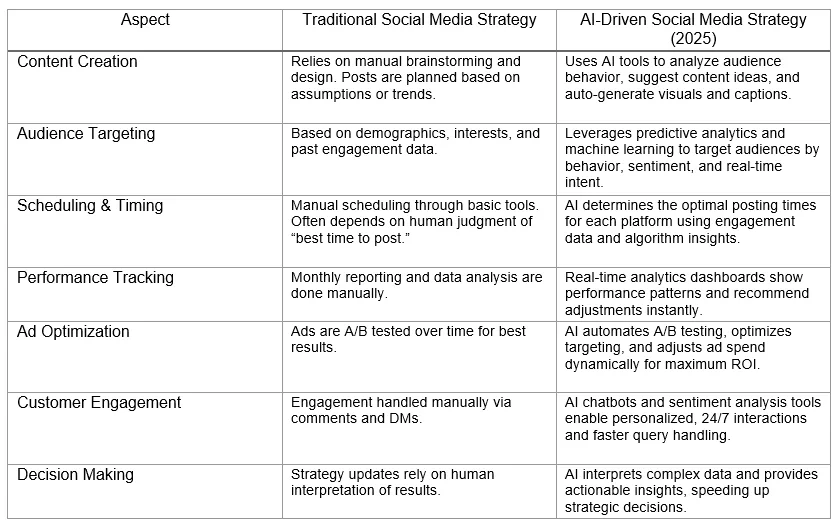
In today’s digital-first era, every brand, whether a startup or a global company, needs a strong social media strategy. With billions of active users across platforms, social media has become the heartbeat of digital marketing. But without structure, even the best content can get lost in the noise.
That’s where a well-defined, AI-powered social media marketing strategy comes in. This guide walks you through 8 actionable steps to create a winning strategy that attracts, engages, and converts.
Step 1: Set Social Media Marketing Goals That Align with Business Objectives
The foundation of a great social media strategy lies in clear, measurable goals. Use the SMART framework Specific, Measurable, Attainable, Relevant, and Time-bound to define what success looks like.
For example:
“Increase Instagram followers by 10% in 3 months through consistent content and influencer collaborations.”
Avoid vanity metrics like likes and shares; instead, focus on meaningful KPIs such as engagement rate, leads generated, or website conversions.
AI Tip: Use tools like HubSpot Social or Sprout Social Insights to automatically track conversions and ROI from each campaign.
Step 2: Learn Everything You Can About Your Audience
Your audience is at the center of every post you create. Without understanding who they are, what they love, and when they’re active, your content may miss the mark.
Start by building audience personas based on demographics, interests, pain points, and buying motivations.
For instance:
- “Sanya, 28 – Fashion Enthusiast, follows lifestyle influencers, shops during online sales.”
Then, use AI-driven analytics tools like Meta Insights, Google Analytics 4, or Audiense to uncover behavioral data such as content preferences, engagement times, and device usage.
These insights help refine your social media content strategy, ensuring every post connects emotionally and strategically.
Step 3: Research the Competition
Your competitors are a goldmine of learning. Conduct a competitive analysis to see what works for them and where the gaps lie.
Track their engagement patterns, hashtags, post frequency, and campaign tone. Use tools like Social Blade, BuzzSumo, or Brandwatch to identify top-performing posts and missed opportunities.
Don’t just copy their strategy; aim to fill the gaps they’re missing.
For example, if competitors are active on Instagram but not on LinkedIn, leverage that platform to capture a new audience segment.
Pro Tip: Set up AI alerts for competitor mentions using Brand24 or Mentionlytics to monitor their moves in real time.
Step 4: Conduct a Social Media Audit
A social media audit helps you understand your current position and what needs improvement.
Ask yourself:
- What’s working and what’s not?
- Which platforms drive the most traffic or engagement?
- How does my content compare to competitors’?
Document the performance of every account, likes, comments, engagement rate, post frequency, and audience sentiment.
AI Insight: Tools like Hootsuite Analytics and Metricool can generate automated audit reports showing which types of content (videos, reels, stories) perform best.
Also, identify imposter accounts or outdated handles. Report fake pages and get your official ones verified to strengthen credibility.
Step 5: Set Up Accounts and Improve Existing Profiles
Now that you know where your audience is, it’s time to optimize your profiles.
Here’s how to create a strong foundation across channels:
- Use consistent branding: logos, tone, and colors.
- Add SEO-rich bios with keywords like “Social Media Marketing Agency in Mumbai”.
- Include links to your website, blogs, or landing pages.
- Use profile images and cover banners that reflect your brand personality.
Every platform should have a purpose:
- Instagram: Visual storytelling & brand awareness.
- LinkedIn: Thought leadership & B2B connections.
- Twitter/X: Real-time updates & customer service.
- YouTube: Educational videos & tutorials.
- Facebook: Community engagement & paid ads.
Step 6: Find Inspiration
Even the most creative marketers need inspiration. Look to brands that are doing social right both within and outside your industry.
Explore:
- Award-winning campaigns: Check the Shorty Awards or Facebook Business Success Stories for ideas.
- Industry trends: Use Pinterest Trends, Google Trends, and BuzzSumo to track what’s trending globally.
- AI-generated ideas: Use ChatGPT or Notion AI for brainstorming captions, carousel ideas, or post hooks.
Remember: inspiration is not imitation. Adapt successful ideas to match your voice, audience, and values.
Step 7: Create a Social Media Content Calendar
Consistency beats perfection. A content calendar keeps your posting structured and aligned with your goals.
Start by defining your content mix:
- 50%: Drive traffic (blogs, offers, new launches)
- 25%: Curated content or industry insights
- 20%: Product/service promotions
- 5%: Team culture or behind-the-scenes
Apply the 80/20 rule: 80% of your posts should educate or entertain, while 20% can directly promote your brand.
Use scheduling tools like Buffer, Later, or Meta Business Suite to plan. This saves time and ensures your messaging stays consistent.
Step 8: Test, Evaluate, and Adjust Your Strategy
No social media strategy is perfect from day one. The key is continuous testing and improvement.
Monitor data across platforms, reach, engagement, click-throughs, conversions, and compare it against your goals. Use UTM tracking to measure which posts or campaigns drive the most website traffic.
Try A/B testing captions, visuals, and post times to learn what resonates.
AI Insight: Tools like Canva Magic Studio, Predis.ai, or Ocoya can test variations of content automatically and suggest optimal posting times.
Lastly, remember social media evolves fast. Revisit your strategy every quarter to stay aligned with algorithm updates and new trends.
Key Takeaway
A powerful social media strategy blends creativity, data, and AI insights. When built thoughtfully, it doesn’t just attract followers, it turns them into loyal brand advocates.
Whether you’re a startup or an established brand, mastering social media is about consistency, experimentation, and connection.
Ready to Build a Data-Driven Social Media Strategy?
At The Marketing Couch, we help brands craft custom social media strategies powered by creativity and AI analytics.
Let’s elevate your online presence, boost engagement, and grow your community authentically.
Contact us today to get started.
Traditional Social Media Strategy vs. AI-Driven Strategy

Frequently Asked Questions
1. How do I improve my brand presence on social media?
Be consistent with content, engage regularly with followers, use trends smartly, and maintain a clear visual identity.
2. How often should I post on social media?
For most brands, 3–5 posts per week per platform work well. Use analytics to determine your ideal frequency.
3. Why is social media strategy important for business?
It ensures your marketing efforts are structured, measurable, and aligned with your business goals.
4. What’s the role of AI in social media marketing?
AI helps in automating analytics, optimizing content performance, and improving targeting accuracy for better ROI.
6. How often should I update my social media plan?
Review your strategy at least every quarter or whenever major platform changes occur. Update your goals, content approach, and ad targeting based on new trends or shifts in audience behavior.
7. Why is social media strategy important for business?
A clear social media strategy ensures your content aligns with your goals, maintains brand consistency, and drives measurable growth. It helps turn followers into loyal customers and keeps your brand relevant online.
8. How do I build a social media strategy for my business?
Start by defining your business goals and target audience. Choose the right platforms, create a content calendar, and track performance with analytics tools. Regularly refine your strategy based on engagement metrics and ROI.








